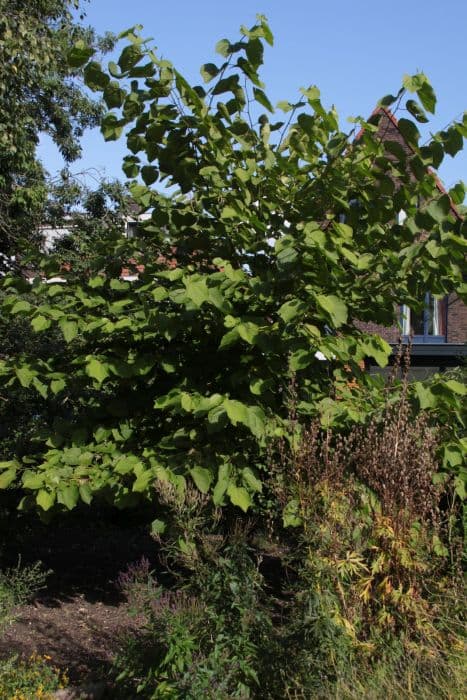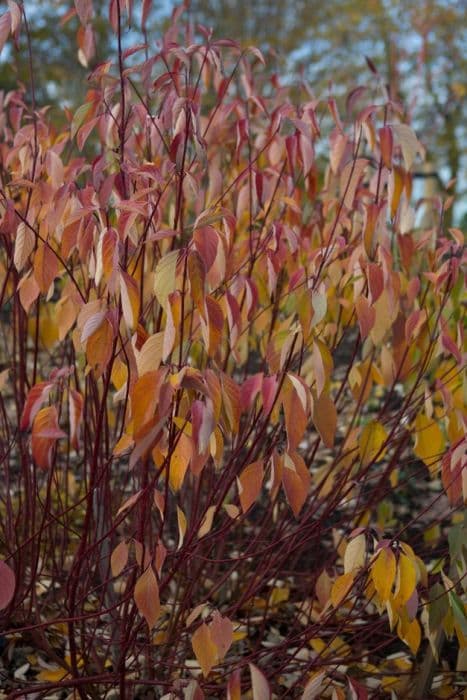Dwarf Bloodtwig Dogwood Cornus sanguinea 'Compressa'










ABOUT
Cornus sanguinea 'Compressa', commonly known as the Bloodtwig Dogwood 'Compressa', is a unique and attractive shrub that stands out in the landscape with its distinctive appearance. This plant is characterized by its tightly packed, upright branches that create a dense and columnar form. The foliage of Bloodtwig Dogwood 'Compressa' is a bright green color, turning to striking shades of purple and red in the fall, which adds a dramatic seasonal interest. The leaves are small, oval-shaped, and come to a subtle point at the end, giving the plant a fine-textured look that is quite pleasing to the eye. In the spring, the Bloodtwig Dogwood 'Compressa' also produces clusters of small, creamy white flowers that can attract butterflies and other pollinators. The flowers provide a soft contrast to the rigid, compact branches. After the blooming period, the flowers give way to spherical blackish-blue fruits, which are favored by birds and can lend an added element of wildlife interest. One of the most notable features of Bloodtwig Dogwood 'Compressa' is its vivid winter stem color. As the name implies, the younger stems can develop a blood-red hue that stands out starkly against the barren winter landscape, providing much-needed color during the colder months. Overall, the Bloodtwig Dogwood 'Compressa' adds a strong vertical element and year-round interest to gardens with its unique growth habit, seasonal foliage changes, flowering and fruiting characteristics, and colorful winter stems.
About this plant
 Names
NamesFamily
Cornaceae
Synonyms
Dwarf Bloodtwig Dogwood, Compressa Dogwood, Columnar Bloodtwig Dogwood
Common names
Cornus sanguinea 'Compressa'.
 Toxicity
ToxicityTo humans
The plant commonly known as Bloodtwig Dogwood is not considered highly toxic to humans. However, it is not recommended for consumption. If ingested in large quantities, parts of the plant might cause mild stomach upset or discomfort. There are no severe toxic effects or symptoms commonly associated with the accidental ingestion of this plant.
To pets
Bloodtwig Dogwood is generally not considered highly toxic to pets such as dogs and cats. However, as with humans, consumption of the plant is not advisable. If a pet were to ingest a large amount of the plant, it might experience mild gastrointestinal upset, including symptoms like vomiting or diarrhea. There are no significant toxic consequences associated with accidental ingestion of the plant by pets.
 Characteristics
CharacteristicsLife cycle
Perennials
Foliage type
Deciduous
Color of leaves
Green
Flower color
White
Height
4-5 feet (1.2-1.5 meters)
Spread
2 feet (0.6 meters)
Plant type
Shrub
Hardiness zones
5
Native area
Europe
Benefits
 General Benefits
General Benefits- Compact Growth: Cornus sanguinea 'Compressa' has a narrow, upright growth habit that is ideal for small gardens or spaces where room is limited.
- Year-Round Interest: This plant provides visual interest throughout all the seasons with its foliage, flowers, and stem color.
- Attractive Bark: The stems have a distinctively bright, reddish-brown bark that stands out in the winter landscape.
- Low Maintenance: 'Compressa' is considered low maintenance, requiring minimal pruning and care once established.
- Drought Tolerance: Once established, it has a good tolerance for periods of drought, making it a good choice for drier climates or water-conservative gardens.
- Wildlife Attraction: The flowers attract pollinators such as bees, and the berries are a food source for birds.
- Easy Propagation: It can be easily propagated through cuttings, allowing gardeners to create more plants for use in their landscape.
- Ornamental Flowers: Produces small, star-shaped white flowers in late spring that are visually appealing.
- Autumn Foliage: Leaves turn to a beautiful range of purple and red hues in the fall, adding to the autumn color palette of the garden.
- Tolerant of a Range of Soils: This plant can thrive in various soil types, from clay to loam and from acidic to alkaline.
 Medical Properties
Medical PropertiesThis plant is not used for medical purposes.
 Air-purifying Qualities
Air-purifying QualitiesThis plant is not specifically known for air purifying qualities.
 Other Uses
Other Uses- Miniature Landscapes: Cornus sanguinea 'Compressa' with its compact growth can be used to create scale replicas of natural landscapes in miniature garden displays.
- Bonsai Specimen: Due to its slow growth and small stature, this plant is an ideal candidate for bonsai, the Japanese art of creating miniature trees.
- Photography Backdrop: The dense, twiggy branches can serve as a rustic and textured backdrop for photographers, especially during autumn and winter.
- Artistic Sketching: The intricate branch patterns can provide inspiration and a challenging subject for artists practicing their sketching skills.
- Educational Tool: Utilized in botany classes to demonstrate pruning techniques and the impact of controlled growth in plant development.
- Fantasy Gaming Terrain: The plant's unusual form can be used in the creation of natural-looking tabletop gaming terrains for games like Warhammer.
- Winter Garden Interest: Its striking red stems add visual interest to dull winter gardens, making it a useful plant for landscape designers.
- Wildlife Shelter: Provides dense cover for small wildlife, including beneficial insects and birds seeking refuge from predators or harsh weather.
- Film and Stage Props: They can be used in theatre productions or film sets to represent forest undergrowth or to create an eerie, twisted woodland scene.
- Craft Material: The compact branches can be harvested and used in the creation of natural craft items like wreaths or rustic home decorations.
Interesting Facts
 Feng Shui
Feng ShuiThe Bloodtwig Dogwood is not used in Feng Shui practice.
 Zodiac Sign Compitability
Zodiac Sign CompitabilityThe Bloodtwig Dogwood is not used in astrology practice.
 Plant Symbolism
Plant Symbolism- Sturdiness: The 'Compressa' variety of the European Dogwood is known for its robust form and hardy nature, symbolizing strength and resilience in the face of adversity.
- Perseverance: With its capacity to adapt to various soil types and environments, this plant represents the ability to endure and persist through challenging conditions.
- Protection: Historically, European Dogwoods were often planted as hedges or borders, illustrating their symbolic role in providing a barrier or shield against external threats.
- Renewal: The vivid red stems of Cornus sanguinea 'Compressa' contrast sharply with its green foliage during the growing season and become even more pronounced in winter, symbolizing renewal and the cyclic nature of life as the seasons change.
 Water
WaterThe Bloodtwig Dogwood 'Compressa' should be watered regularly to keep the soil moist but not waterlogged. During the growing season, it's essential to water the plant thoroughly once a week, providing about 1 to 1.5 gallons depending on the weather conditions and soil drainage. During hot, dry spells, increase watering frequency to twice a week. In the winter, reduce the watering to every two weeks or less, as the plant will require less moisture during dormancy. Ensure that the plant has good drainage to prevent root rot, and always check the top inch of the soil for dryness before watering.
 Light
LightBloodtwig Dogwood 'Compressa' thrives in a location with full sun to partial shade. Ideally, it should receive at least four to six hours of direct sunlight daily, but it can also tolerate some light shade, particularly during the hottest part of the day. Avoid placing it in deep shade, as this can hinder growth and reduce the vibrancy of the foliage and stems.
 Temperature
TemperatureBloodtwig Dogwood 'Compressa' is hardy and can tolerate a wide range of temperatures; however, it prefers a moderate climate. It can survive minimum winter temperatures down to -20 degrees Fahrenheit and is comfortable in summer temperatures up to 95 degrees Fahrenheit. The ideal temperature range for this plant is between 60 and 75 degrees Fahrenheit, where it can grow most vigorously.
 Pruning
PruningPruning the Bloodtwig Dogwood 'Compressa' is important for maintaining its compact shape and encouraging vibrant stem color. Prune in late winter or early spring before new growth begins, removing any damaged or diseased branches. Additionally, cutting back a third of the oldest stems each year helps stimulate the growth of new stems which have the best color. The best time for pruning is typically late February to early April, depending on the local climate.
 Cleaning
CleaningAs needed
 Soil
SoilBloodtwig Dogwood 'Compressa' thrives in moist, well-drained soil with an acidic to neutral pH between 5.5 and 7.0. A mix of loamy soil, peat, and coarse sand or perlite can create ideal conditions for root health and drainage.
 Repotting
RepottingBloodtwig Dogwood 'Compressa' generally does not need frequent repotting and should be repotted only once it outgrows its current container, which may be every 2-4 years.
 Humidity & Misting
Humidity & MistingBloodtwig Dogwood 'Compressa' prefers moderate humidity levels but is adaptable to a wide range of humidity conditions found in typical outdoor environments.
 Suitable locations
Suitable locationsIndoor
Place 'Compressa' in bright light with moist soil.
Outdoor
Choose partial shade, mulch well, keep soil moist.
Hardiness zone
4-8 USDA.
 Life cycle
Life cycleCornus sanguinea 'Compressa', commonly known as the Dwarf Bloodtwig Dogwood, starts its life cycle when the seeds germinate in late spring, after which the seedlings establish themselves, growing roots and foliage. The plant enters a rapid vegetative growth phase through the spring and summer, developing a characteristic compact form with dense leaves. In the following years, as a perennial, it will go dormant in the fall and winter, losing its leaves before entering a period of dormancy where the bright red stems stand out in the garden. Once mature, the Dwarf Bloodtwig Dogwood will produce small white flowers typically in late spring to early summer, followed by clusters of dark-colored berries that attract wildlife, signaling the reproductive stage. After pollination and berry formation, seeds are dispersed, often by birds, which then leads to the next generation of plants. Throughout its life cycle, regular pruning maintains its shape and promotes healthy growth, while the plant can live many years with proper care.
 Propogation
PropogationPropogation time
Early Spring
The most popular method of propagation for Cornus sanguinea 'Compressa', commonly known as Bloodtwig dogwood, is by softwood cuttings. This is typically done in late spring or early summer, when the new growth is mature enough yet still soft. You would cut a piece of stem about 6 inches (around 15 cm) long, making sure it has at least two sets of leaves. The lower leaves are removed, and the cut end dipped in rooting hormone before it is placed in a well-draining soil mix. The cutting should then be kept moist and in indirect light until roots develop, which usually takes a few weeks. After the cutting has rooted sufficiently, it can be transplanted into a larger pot or directly into the ground, depending on the size of the roots and the outside temperature.









